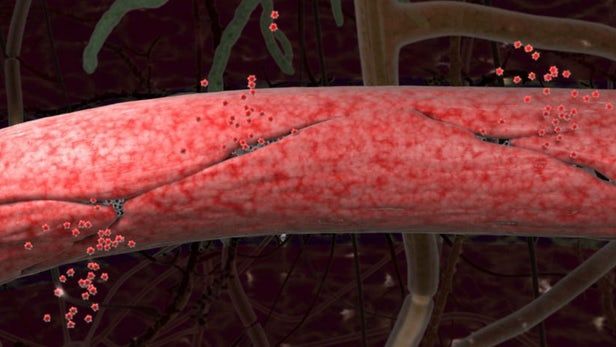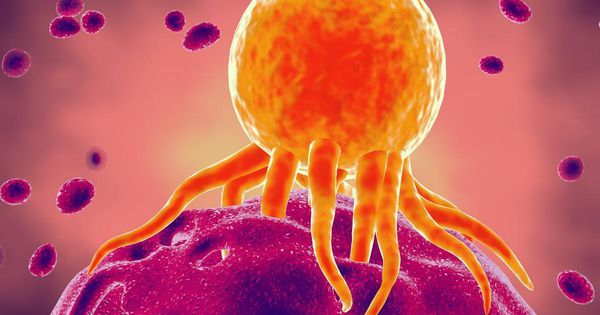Researchers with the University of Michigan have developed a new 3D printing technology that is capable of printing 100 times faster than normal 3D printers. Unlike traditional 3D printers, which work by applying plastic down as layers, the new technology involves resin that is solidified upward at rapid speeds. The new method is capable of producing complex objects at speeds that traditional printers can’t compete with.
Year: 2019 – Page 1,144

Leaky blood-brain barrier identified as potential early-warning sign for Alzheimer’s
New research published in the journal Nature Medicine has described the results of a five-year study into the association between a breakdown of the blood-brain barrier and the onset of cognitive impairment. The study suggests leaky capillaries in the brain can act as an early biomarker of cognitive decline, and a new drug being developed for stroke patients may be an effective treatment.

Experiments detect entropy production in mesoscopic quantum systems
The production of entropy, which means increasing the degree of disorder in a system, is an inexorable tendency in the macroscopic world owing to the second law of thermodynamics. This makes the processes described by classical physics irreversible and, by extension, imposes a direction on the flow of time. However, the tendency does not necessarily apply in the microscopic world, which is governed by quantum mechanics. The laws of quantum physics are reversible in time, so in the microscopic world, there is no preferential direction to the flow of phenomena.
One of the most important aims of contemporary scientific research is knowing exactly where the transition occurs from the quantum world to the classical world and why it occurs — in other words, finding out what makes the production of entropy predominate. This aim explains the current interest in studying mesoscopic systems, which are not as small as individual atoms but nevertheless display well-defined quantum behavior.

The Brain’s Autopilot Mechanism Steers Consciousness
Freud’s notion of a dark, libidinous unconscious is obsolete. A new theory holds that the brain produces a continuous stream of unconscious predictions.
- By Steve Ayan on December 19, 2018

CERN Unveils Design for 62-Mile-Round Atom Smasher More Powerful Than the Large Hadron Collider
A scientific collaboration has released a concept design for the Large Hadron Collider’s successor, an enormous new experiment that would sit inside a hundred-kilometer (62-mile) tunnel.
The design concept plans for two Future Circular Colliders, the first which would begin operation perhaps in 2040. The ambitious experiments would hunt for new particles with collision energies 10 times higher than those created by the Large Hadron Collider (LHC). The concept design is the first big milestone achieved by the scientific collaboration.

Researchers discover new evidence of superconductivity at near room temperature
Researchers at the George Washington University have taken a major step toward reaching one of the most sought-after goals in physics: room temperature superconductivity.
Superconductivity is the lack of electrical resistance and is observed in many materials when they are cooled below a critical temperature. Until now, superconducting materials were thought to have to cool to very low temperatures (minus 180 degrees Celsius or minus 292 degrees Fahrenheit), which limited their application. Since electrical resistance makes a system inefficient, eliminating some of this resistance by utilizing room temperature superconductors would allow for more efficient generation and use of electricity, enhanced energy transmission around the world and more powerful computing systems.
“Superconductivity is perhaps one of the last great frontiers of scientific discovery that can transcend to everyday technological applications,” Maddury Somayazulu, an associate research professor at the GW School of Engineering and Applied Science, said. “Room temperature superconductivity has been the proverbial ‘holy grail’ waiting to be found, and achieving it—albeit at 2 million atmospheres—is a paradigm-changing moment in the history of science.”


This Quadruple Star System Is Unlike Anything We’ve Ever Seen Before
Astronomers using the ALMA telescope have discovered an oddly tilted planet-forming disk within a double binary star system, a configuration that up until this point only existed in theory.
Quadruple star systems featuring two binary pairs are nothing unusual, nor is the discovery of a surrounding protoplanetary disk—a ring of gas and dust that gradually congeals to form planets. A star system located 146 light-years from Earth, called HD 98800, has all these things, but as new research published today in Nature Astronomy reveals, this system features an exceptionally strange protoplanetary disk.

Newly Discovered Mechanism Helps Our Own Immune Systems Fight Cancer
In the study, researchers focused on a mechanism that routinely serves the cell by marking human virus-like genes in order to avoid identifying them as viruses. Together with the Harvard team, Levanon has discovered that “when inhibiting this mechanism, the immune system can be harnessed to fight cancer cells in a particularly efficient manner, and most effectively in lung cancer and melanoma.”
“We found that if the mechanism is blocked, the immune system is much more sensitive,” Levanon said. “When the mechanism is deactivated, the immune system becomes much more aggressive against the tumor cells.”
According to researchers, most patients with cancer either do not respond to immune checkpoint blockade (a type of drug that blocks certain proteins made by some types of immune system cells, such as T cells, and some cancer cells) or develop resistance to it. The National Cancer Institute (NCI) says these proteins help keep immune responses in check and can keep T cells from killing cancer cells. “When these proteins are blocked, the ‘brakes’ on the immune system are released and T cells are able to kill cancer cells better,” says the NCI. Some immune checkpoint inhibitors are used to treat cancer as immunotherapy uses the body’s immune system to fight cancer.